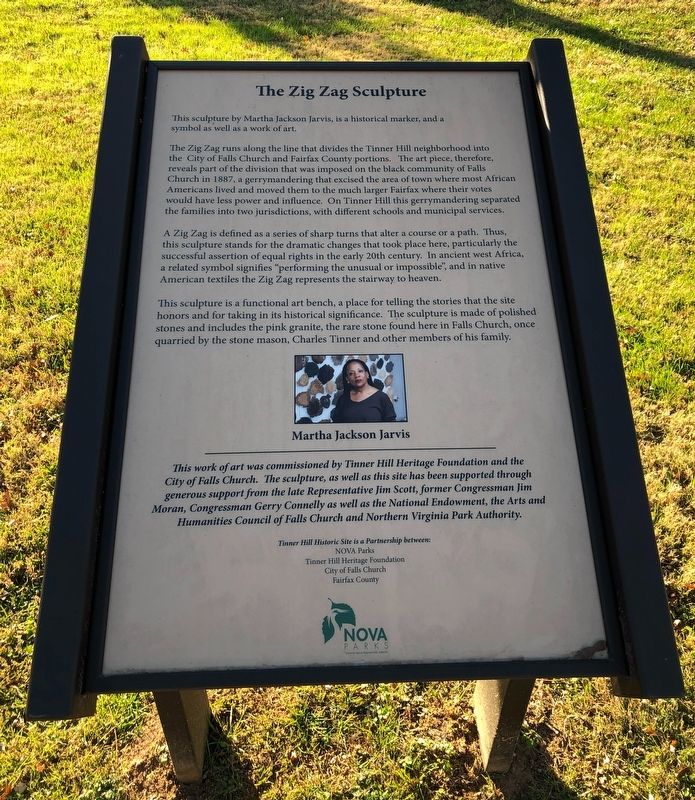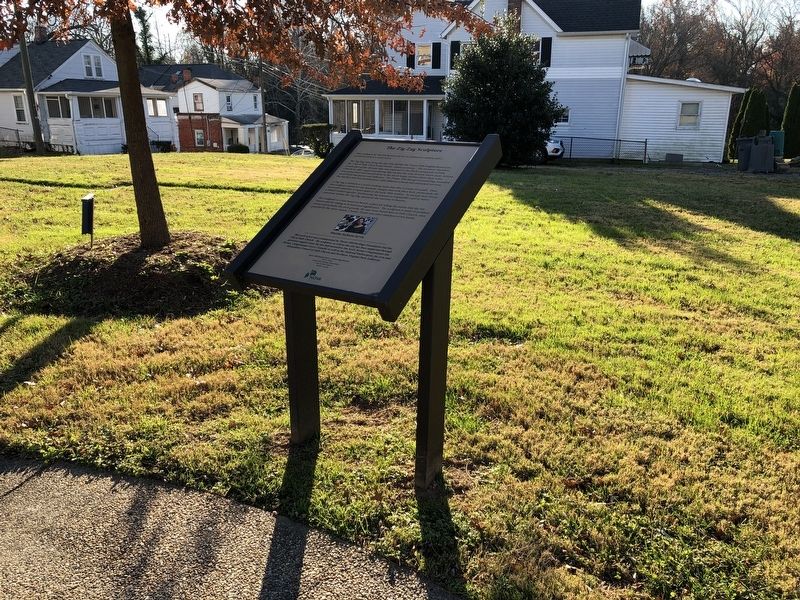Falls Church, Virginia — The American South (Mid-Atlantic)
The Zig Zag Sculpture
Martha Jackson Jarvis
This sculpture by Martha Jackson Jarvis, is a historical marker, and a symbol as well as a work of art.
The Zig Zag runs along the line that divides the Tinner Hill neighborhood into the City of Falls Church and Fairfax County portions. The art piece, therefore, reveals part of the division that was imposed on the black community of Falls Church in 1887, a gerrymandering that excised the area of town where most African Americans lived and moved them to the much larger Fairfax where their votes would have less power and influence. On Tinner Hill this gerrymandering separated the families into two jurisdictions, with different schools and municipal services.
A Zig Zag is defined as a series of sharp turns that alter a course or a path. Thus, this sculpture stands for the dramatic changes that took place here, particularly the successful assertion of equal rights in the early 20th century. In ancient west Africa, a related symbol signifies "performing the unusual or impossible", and in native American textiles the Zig Zag represents the stairway to heaven.
This sculpture is a functional art bench, a place for telling the stories that the site honors and for taking in its historical significance. The sculpture is made of polished stones and includes the pink granite, the rare stone found here in Falls Church, once quarried by the stone mason, Charles Tinner and other members of his family.
This work of art was commissioned by Tinner Hill Heritage Foundation and the City of Falls Church. The sculpture, as well as this site has been supported through generous support from the late Representative Jim Scott, former Congressman Jim Moran, Congressman Gerry Connelly as well as the National Endowment, the Arts and Humanities Council of Falls Church and Northern Virginia Park Authority.
Erected by NOVA Parks, Tinner Hill Heritage Foundation, City of Falls Church, Fairfax County.
Topics and series. This historical marker is listed in these topic lists: African Americans • Anthropology & Archaeology • Arts, Letters, Music • Civil Rights • Native Americans • Political Subdivisions • Women. In addition, it is included in the NOVA Parks series list. A significant historical year for this entry is 1887.
Location. 38° 52.748′ N, 77° 10.595′ W. Marker is in Falls Church, Virginia. Marker is on Tinner Hill Road just south of South Washington Street (U.S. 29), on the right when traveling south. Touch for map. Marker is at or near this postal address: 106 Tinner Hill Rd, Falls Church VA 22042, United States of America. Touch for directions.
Other nearby markers. At least 8 other markers are within walking distance of this marker.
Additional commentary.
1. Location of the marker
The marker and the sculpture both lie legally, if barely, in the City of Falls Church. Part of the partially in the City of Falls Church and Fairfax County.
— Submitted November 28, 2021, by Devry Becker Jones of Washington, District of Columbia.
2. About NOVA Parks
NOVA Parks is a regional park authority. Both Fairfax County and the City of Falls Church are components of the regional authority.
— Submitted November 28, 2021, by Devry Becker Jones of Washington, District of Columbia.
Credits. This page was last revised on November 29, 2021. It was originally submitted on November 28, 2021, by Devry Becker Jones of Washington, District of Columbia. This page has been viewed 265 times since then and 43 times this year. Photos: 1, 2, 3. submitted on November 28, 2021, by Devry Becker Jones of Washington, District of Columbia.


